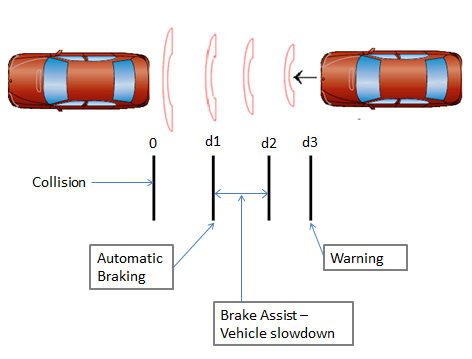Autonomous Emergency Braking Systems
- Basic Description
-
A study conducted by the German Association of Insurance revealed that 50% of rear-end collisions occur without any braking and as much as 70% occur with braking that is insufficient to stop the vehicle in time. Furthermore, nearly 75% of all accidents that result in injuries happen within city limits at speeds below 20 mph. Autonomous emergency braking (AEB) systems are designed to avoid or minimize the damage caused by these types of accidents.

AEB (also referred to as automatic emergency braking or crash-imminent braking) systems monitor conditions ahead of the vehicle. If a crash appears to be imminent, these systems will automatically apply an appropriate braking pressure. Continental’s Emergency Brake Assist system, for example, uses three laser beams level with the rear-view mirror to scan the road for obstacles up to eight meters ahead. The system is capable of preventing collisions if the speed differential between the two vehicles is less than 10 mph. At speeds greater than 10 mph, the system can reduce the severity of impact.
The Volvo XC60 implements a dual-mode detection technology from Continental that is capable of detecting pedestrians as well as other vehicles and applying full brake pressure at 2 to 18 mph. The system uses an infrared laser located behind the rear-view mirror and high resolution cameras for image detection. The combination of the two sensing technologies enables the system to more accurately assess the situation to further aid in accident prevention. Other systems use radar and/or image sensors to detect potential obstacles in the road ahead.
The first AEB system on a passenger car was introduced on the Volvo XC60 in the 2010 model year. The Highway Loss Data Institute (HLDI) found that Volvo XC60s equipped with this feature had significantly fewer claims compared to other mid-size luxury SUVs. A study by Euro NCAP found that "Real world performance data suggests AEB systems can reduce accidents by up to 27%." Euro NCAP and other agencies that rate vehicle safety now require that vehicles have AEB in order to receive their top safety rating. In 2014, more than 20% of the vehicle models in HLDI's database offered AEB as an option.
Most AEB systems do not brake until the last possible moment, after warning the driver using acoustic as well as visual warnings. This braking is usually activated later than a normal driver who is concentrating on the road would brake. Hence the system is less likely to interfere with normal driving and drivers are less likely to become dependent on the system for braking.
- Sensors
- Headway sensor (radar), image sensor, vehicle speed sensor, accelerator pedal position, brake pedal position
- Actuators
- Brakes, warning display, audible alarm, seatbelt tensioner
- Data Communications
- CAN or FlexRay
- Manufacturers
- Bosch, Continental, Daimler, Delphi, Hyundai, TRW, Volvo
- For More Information
- [1] Automatic Braking in Cars Helps Cut Down on Crashes, USA Today, July 19, 2011.
- [2] Volvo City Safety – Laser Radar Auto Brake Safety System, YouTube, June 2, 2011.
- [3] Auto Braking: A Quantum Leap for Road Safety, Chris Knapman, The Telegraph, Aug. 14, 2012.
- [4] Toyota System Detects Pedestrians, Avoids Collisions,YouTube, July 22, 2011.
- [5] Do Automatic Braking Systems Save Lives?, Esuranceblog, May 9, 2013.
- [6] Autonomous Emergency Braking Systems, YouTube, Nov. 2, 2013.
- [7] Autonomous Emergency Braking, YouTube, Aug. 26, 2014.
- [8] Volvo Buses Auto Braking System, YouTube, Sep. 23, 2014.
- [9] Government Pushes Autonomous Braking Technology, Consumer Reports, Jan. 23, 2015.
- [10] Not All Automated Emergency Braking Systems Are Created Equal, Car and Driver, Aug. 25, 2016.
|

